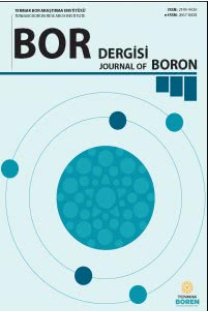Effect of silanization time on the surface modification of anhydrous borax
Effect of silanization time on the surface modification of anhydrous borax
___
- [1] Haber R.A., Powders: Prefiring, in Concise Encyclopedia of Advanced Ceramic Materials, ed. R. J. Brook, Pergamon Press, pp. 377-380, 1991.
- [2] Otles M.S., Modification of surface properties of biopowders by dry particle coating, Ph.D. Thesis, Université de Toulouse, INPT, 2008.
- [3] Saleh K., Guigon P., Coating and Encapsulation Processes in Powder Technology, Elsevier, 1st edition, Handbook of Powder Technol. vol. 11, ch. 7, 323-375, 2007.
- [4] Yusoff S. M., Ahmad M. S. B., Akil H. M., Ariffin K. S., Ariffin A., Contact angle of untreated-treated kaolin and its correlation with the mechanical properties of PP–kaolin composites, J. Reinf. Plast. Compos., 29 (23), 3442–3449, 2010.
- [5] Lin B., Chen J., Li Z. T., He F. A., Li D. H., Superhydrophobic modification of polyurethane sponge for the oilwater separation, Surf. Coat. Technol., 359, 216–226, 2019.
- [6] Zhang W., Li X., Shan Z., Wang S., Xiao Y., Surface modification of magnesium hydroxide by wet process and effect on the thermal stability of silicone rubber, Appl. Surf. Sci., 465, 740–746, 2019.
- [7] Richard E., Aruna S. T., Basu B. J., Superhydrophobic surfaces fabricated by surface modification of alumina particles, Appl. Surf. Sci., 258, 10199–10204, 2012.
- [8] Bayık G. D., Altın A., Conversion of an industrial waste to an oil sorbent by coupling with functional silanes, J. Cleaner Prod., 196, 1052-1064, 2018.
- [9] McMillian P. W., Glass-Ceramics, 2nd edition, Academic Press, New York, 1979.
- [10] Akbay E., Altiokka M. R., Kinetics of borax dehydration by thermal analysis, Anadolu Univ. J. Sci. Technol. AAppl. Sci. Eng., 18, (3), 713-719, 2017.
- [11] Kocakuşak S., Akcay K, Ayok T., Tolun R., Production of anhydrous, crystalline borax in a fluidized bed, Ind. Engi. Chem. Res., 35 (4), 1996.
- [12] Eti Mine Enterprises, Boron products technical data sheet (in Turkish), 1-107, 2018.
- [13] Derluyn H., Moonen P., Carmeliet J., Numerical modelling of crystallization induced damage processes, Workshop CRYSPOM III, Crystallization in porous media, Portugal, 2012.
- [14] Cooke R. U., Smalley I. J., Salt weathering in deserts, Nature, 220, 1226-1227, 1968.
- [15] Flatt R. J., Caruso F., Sanchez A.M.A., Scherer G. W., Chemo-mechanics of salt damage in stone, Nat. Commun., 5, 4823, 2014.
- [16] Charola A. E., Weber J., The hydration-dehydration mechanism of sodium sulphate. In: 7th International Congress on Deterioration and Conservation of Stone, Proc. Lisbon: LNEC, 581-590, 1992.
- [17] Rodriguez-Navarro C., Doehne E., Sebastian E., How does sodium sulphate crystallize? Implications for the decay and testing of building materials, Cem. Concr. Res., 30 (10), 1527-1534, 2000.
- [18] Kaplan J., Zamek J., A substitute for gerstley borate, Ceram. Tech.,32, 24-29, 2011.
- [19] Gomez-Tena M.P., Moreno A., Bou E., Cook S., Galindo M., Vicente M. J., Use of a new borate raw material for glaze formulation, Bol. Soc. Esp. Ceram. Vidr. 49 (4), 319-326, 2010.
- [20] Kang J. S., Yu C.L., Zhang F. A., Effect of silane modified SiO2 particles on poly(MMA-HEMA) soap-free emulsion polymerization, Iran Polym. J., 18 (12), 927– 935, 2009.
- [21] Tao Q., Su L., Frost R. L., Zhang D., Chen M., Shen W., He H., Silylation of mechanically ground kaolinite, Clay Miner., 49, 559–568, 2014.
- [22] Jain R., Formation of aminosilane and thiol monolayers on semiconductor surfaces and bulk wet etching of III-V semiconductors, PhD thesis, Chemical and Environmental Engineering Department, The University of Arizona, 2012.
- [23] Krasnoslobodtsev A. V., Smirnov S. N., Effect of water on silanization of silica by trimethoxysilanes, Langmuir, 18 (8), 3181-3184, 2002.
- [24] Kyaw H. H., Al-Harthi S. H., Sellai A,. Dutta J., Self-organization of gold nanoparticles on silanated surfaces, Beilstein Journal of Nanotechnology 6, 2345, 2015.
- [25] Bressy C., Ngo V. G., Ziarelli F., Margaillan A., New insights into the adsorption of 3-(trimethoxysilyl)propylmethacrylate on hydroxylated ZnO nanopowders, Langmuir, 28 (6), 2012.
- [26] Zhang J., Surface modification and subsequent silver coating onto nanoscale calcium carbonate for antibacterial fabrication, 2011 International Conference on Electronics and Optoelectronics (ICEOE 2011), 2011.
- [27] Popat K. C., Johnson R. W., Desai T. A., Characterization of vapor deposited thin silane films on silicon substrates for biomedical microdevices, Surf. Coat. Technol., 154, 253-261, 2002.
- [28] Moiseev L., Unlu M. S., Swan A. K., Goldberg B. B., Cantor C. R., DNA conformation on surfaces measured by fluorescence self-interference, Proc. Natl. Acad. Sci. U.S.A., 103 (8), 2623-2628, 2006.
- [29] Zhang F., Srinivasan M. P., Self-Assembled Molecular Films of Aminosilanes and Their Immobilization Capacities, Langmuir, 20 (6), pp.2309-2314, 2004.
- [30] White L. D., Tripp C. P., Reaction of (3-Aminopropyl) dimethylethoxy silane with Amine Catalysts on Silica Surfaces, J. Colloid Interface Sci., 232 (2), 400-407, 2000.
- ISSN: 2149-9020
- Yayın Aralığı: 4
- Başlangıç: 2016
- Yayıncı: TENMAK Bor Araştırma Enstitüsü
Effect of silanization time on the surface modification of anhydrous borax
Uğur GÖKMEN, Zübeyde ÖZKAN, Leili Eslam JAMALGOLZARİ, Sema BİLGE OCAK
Box–Behnken experimental design for zinc borate Zn2 B6 O11·7H2 O
First principles investigations of Ta4 AlX3(X= B, C, N) MAX phase ceramics
Uğur Gökmen, Zübeyde Özkan, Leili Eslam Jamalgolzari, Sema Bilge Ocak
Characterization of surface properties of dry-coated anhydrous borax powders
